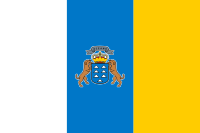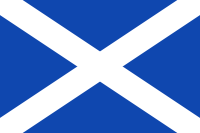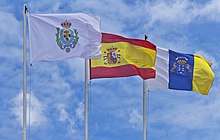
 Flag of the Autonomous Community of the Canary Islands. Flag ratio: 2:3
Flag of the Autonomous Community of the Canary Islands. Flag ratio: 2:3
 Flag of the Autonomous Community of the Canary Islands with coat of arms. Flag ratio: 2:3
Flag of the Autonomous Community of the Canary Islands with coat of arms. Flag ratio: 2:3

The flag of the Autonomous Community of the Canary Islands is a vertical tricolour of three equal bands of white, blue, and yellow. The state flag includes the Coat of arms of the Canary Islands in the central band; the civil flag omits this. The designs were made official by the Statute of Autonomy of the Canarian Autonomous Community (Organic Law 10/82) on 16 August 1982.
History and meaning
[edit]The tricolour flag has its origins in the Canarias Libre movement of the 1960s. It was designed by Carmen Sarmiento and her sons Arturo and Jesus Cantero Sarmiento, and first displayed (in paper form) on 8 September 1961. It combined the blue and white colours of the Province of Santa Cruz de Tenerife (Province of Canary Islands) with the blue and yellow colours of the Province of Las Palmas.[1] The two dogs represented on flag's seal centered on the flag are Perro de Presa Canarios, or Canary Catch Dogs, that were first bred on the Canary Islands by ranchers who use them to herd and protect their cattle. [2]
Colours
[edit]The colours of the flag as specified by the Canarian Government are the following:[3]
| Pantone | CMYK colour model | RGB colour model | Web colours | ||||||
|---|---|---|---|---|---|---|---|---|---|
| Colour | Identification | C | M | Y | K | R | G | B | HTML code |
| White* | Not specified | 0% | 0% | 0% | 0% | 255 | 255 | 255 | #FFFFFF
|
| Blue | 3005 | 100% | 35% | 0% | 0% | 7 | 104 | 169 | #0768A9
|
| Yellow | 7406 | 0% | 20% | 100% | 0% | 255 | 204 | 0 | #FFCC00
|
*Assumed to be pure white due to it not being specified exactly.
Flags of the provinces
[edit]-
Flag of Santa Cruz de Tenerife
-
Flag of Las Palmas
Island flags
[edit]-
Flag of El Hierro
-
Flag of La Palma
-
Flag of La Gomera
-
Flag of Tenerife
-
Flag of Gran Canaria
-
Flag of Fuerteventura
-
Flag of Lanzarote
Other versions
[edit]-
Banner of Kingdom of the Canary Islands under Jean de Béthencourt
-
Canarian flag proposed by Azarug
-
"Ateneo Flag", the first Canarian nationalist flag. The seven stars represent the seven islands of the archipelago
-
The flag proposed by the CIIM.
-
Flag adopted by the Canarias Libre Movement
See also
[edit]
References
[edit]External links
[edit]- Canary Islands at Flags of the World
- Banderas de Canarias by José Manuel Erbez.
- Canary Islands Flag - History & Meaning by Guide to Canary Islands














Well, that’s interesting to know that Psilotum nudum are known as whisk ferns. Psilotum nudum is the commoner species of the two. While the P. flaccidum is a rare species and is found in the tropical islands. Both the species are usually epiphytic in habit and grow upon tree ferns. These species may also be terrestrial and grow in humus or in the crevices of the rocks.
View the detailed Guide of Psilotum nudum: Detailed Study Of Psilotum Nudum (Whisk Fern), Classification, Anatomy, Reproduction